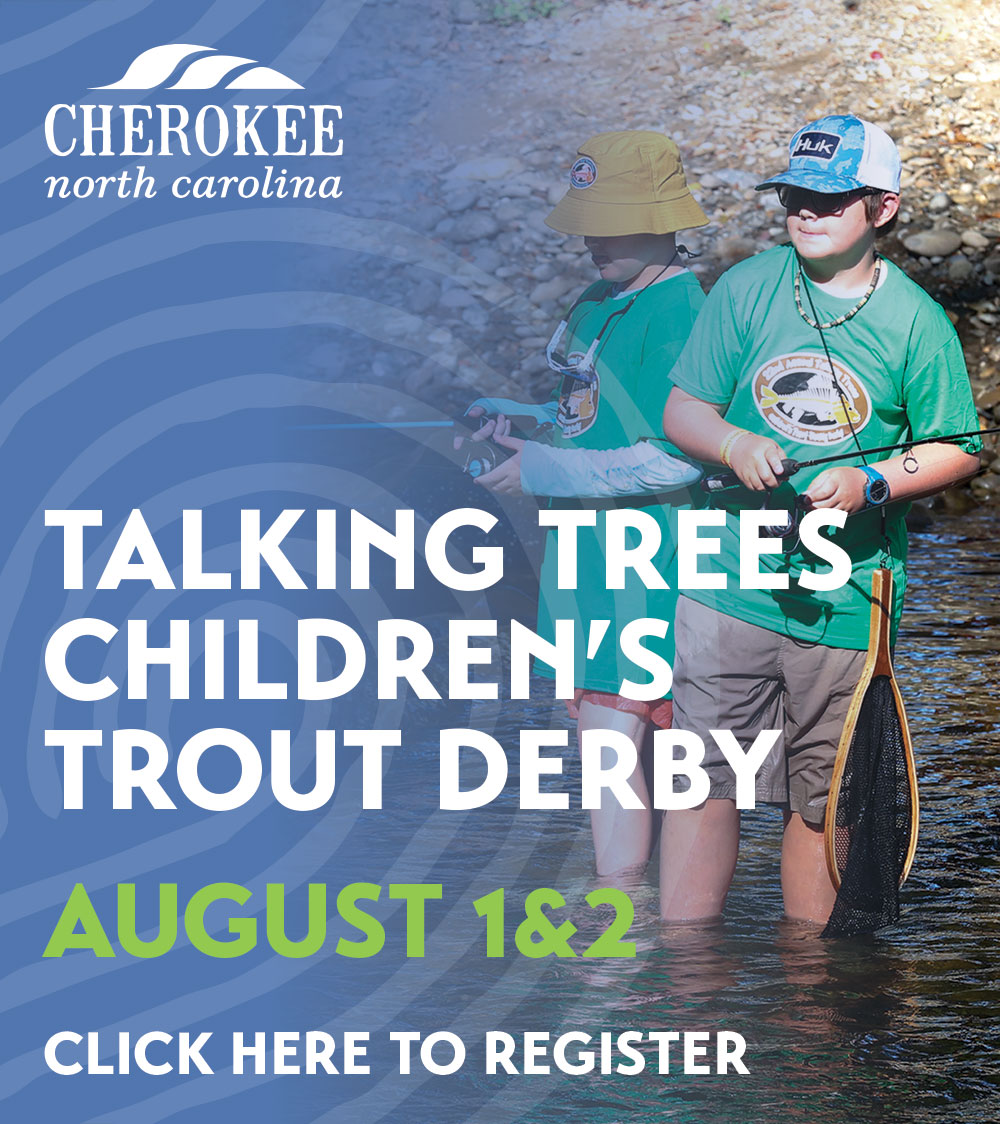By SCOTT MCKIE B.P.
One Feather Asst. Editor
CHEROKEE, N.C. – The Sacred Fire Courtyard, designed to look like a Cherokee Stomp Dance Ground, was dedicated at the Cherokee Indian Hospital on the afternoon of Friday, Dec. 8. The centerpiece of the Courtyard is a copper sculpture of a fire and seven Cherokee Clan masks by Nathan Bush and James “JR” Wolfe, both members of the Eastern Band of Cherokee Indians, and William Rogers, a master craftsman who has been mentoring Bush and Wolfe for several years.
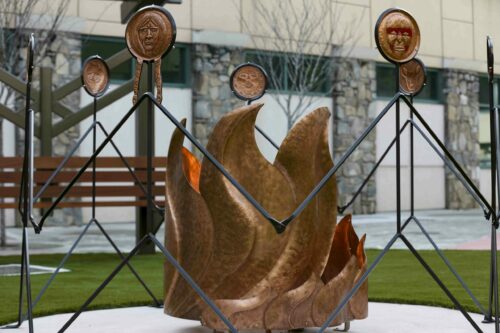
The Sacred Fire Courtyard, designed to look like a Cherokee Stomp Dance Ground, was dedicated at the Cherokee Indian Hospital on the afternoon of Friday, Dec. 8. The centerpiece of the Courtyard is a copper sculpture of a fire and seven Cherokee Clan masks. (SCOTT MCKIE B.P./One Feather photos)
“Even though this is not exactly what you would find at a stomp ground, it’s representational of that,” Bo Taylor, a member of the Eastern Band of Cherokee Indians, said during the event. “There’s one word that I love to use and it’s intentional. If you have intention, you can do great things. If you want sobriety and you have intention, you can do that. You have to make it happen. You have to have a place to go to get in touch with Creator, to get in touch with your roots.”
Taylor added, “The fire is such an important part of who we are…the fire that burns up in the sky, and the ones that burn on these mounds, and the one that burns in our soul – as long as we keep our traditions alive, as long as we keep doing our dances, as long as we keep speaking our language, as long as we’re intentional with who we are as Cherokees, the world will keep turning. That’s why I believe so hard in having intention with what we do.”
Casey Cooper, Cherokee Indian Hospital Authority chief executive officer, told the crowd, “Hopefully the community really loves and appreciates how intentional the hospital system has been in memorializing our culture in permanent elements of the architecture so that we can celebrate it and talk about it into perpetuity. We really believe that there’s no way to have a stronger, healthier community unless we fully embrace our culture and who we are and where we come from. We believe that’s where our strength and our resilience comes from.”
Cooper said the project was very collaborative and noted they worked with Taylor; Shana Bushyhead Condill, Dakota Brown, and Michael Slee from the Museum of the Cherokee People; the Cherokee Preservation Foundation; MPS (designers); and Robins & Morton (project managers).
“We were able to then partner with William Rogers, the metalsmith, and Nathan Bush, and J.R. Wolfe who brought this beautiful sculpture to fruition so that we could celebrate the clans appropriately and celebrate all the initial elements of stomp. The most important thing is that it’s here for the community. It’s here for everybody to come and celebrate and enjoy.”
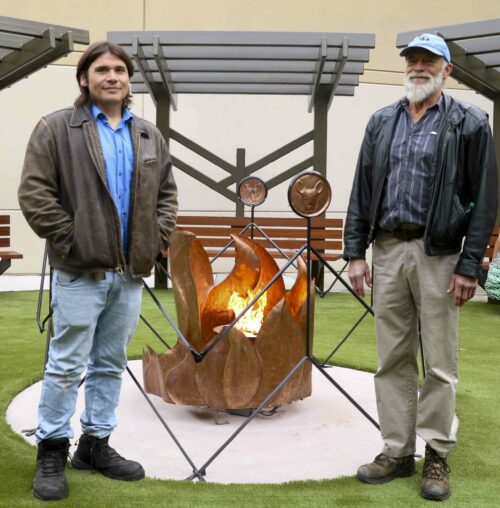
The copper sculpture was constructed by Nathan Bush, left, William Rogers, right, and James “JR” Wolfe who is not pictured. Bush and Wolfe are both members of the Eastern Band of Cherokee Indians, and Rogers is a master craftsman who has been mentoring Bush and Wolfe for several years.
The copper sculpture piece was commissioned by the Cherokee Indian Hospital Foundation through a grant from the Cherokee Preservation Foundation. This current work is their third large copper sculpture that can be seen in western North Carolina including a piece at the Stecoah Valley Cultural Arts Center representing the Cherokee Eternal Flame and one at the Cherokee Indian Hospital entitled “Grandfather Buzzard” that flies above the hospital’s river walk area.
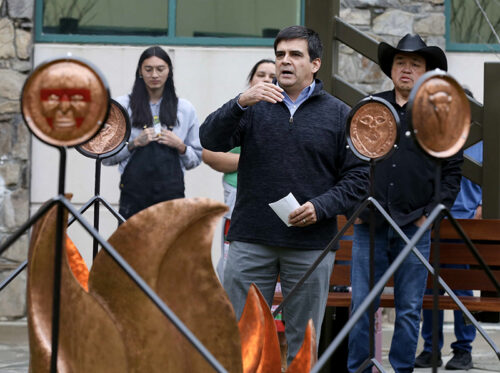
Seven pieces representing Cherokee Clan Masks are included in the copper sculpture including this one representing the Long Hair Clan.
Rogers told the One Feather, “It was a great collaboration. There were just so many people that got it going, got it started, figured out how to make it work, and really got it to fruition. This is definitely a good way to seed it into position with the community.”
Several years ago, Rogers received a Folklife Apprenticeship grant from the N.C. Arts Council that allowed him to mentor Bush and Wolfe to teach and share hammered copper and blacksmithing skills. Information from the Arts Council states, “Rogers, Bush, and Wolfe are working to revive Cherokee metalsmithing knowledge and practice, and to make it ‘come alive again’ in Cherokee’s schools and craft centers like the Oconaluftee Indian Village.”
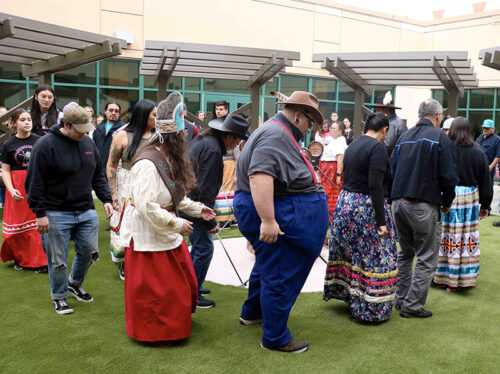
Several stomp dance songs were sung during the dedication event.
Bush commented to the One Feather that he was really happy with how the sculpture turned out. “It turned out way better than I was thinking, with all the extra stuff around it. I was thinking it was just going to be this, but with the benches all around it, it looks really beautiful in this little area right here.
“I’m glad to see it fully complete because I’ve not seen it complete yet. I’ve just seen it in pieces. Seeing it complete like that is something else.”
He went on to say, “It’s something else to see something you’ve worked on and see it complete. It was truly an honor to get to work on it, especially with William and J.R. William is the reason why we have this craft back from the dead. If it wasn’t for him, we wouldn’t have learned this. Thanks to William Rogers we have an old tradition come back from the past. Hopefully we have a lot of students who get inspired by this piece and will want to learn this craft and keep it going in the future.”
Taylor summed up the sentiment on the Courtyard as he told the crowd, “As Cherokees, we’ve got to remember, as technology-forward that we are and as a great nation that we have become, that we are still Native, that we still have cultural beliefs that we should embrace and keep and perpetuate for always.”
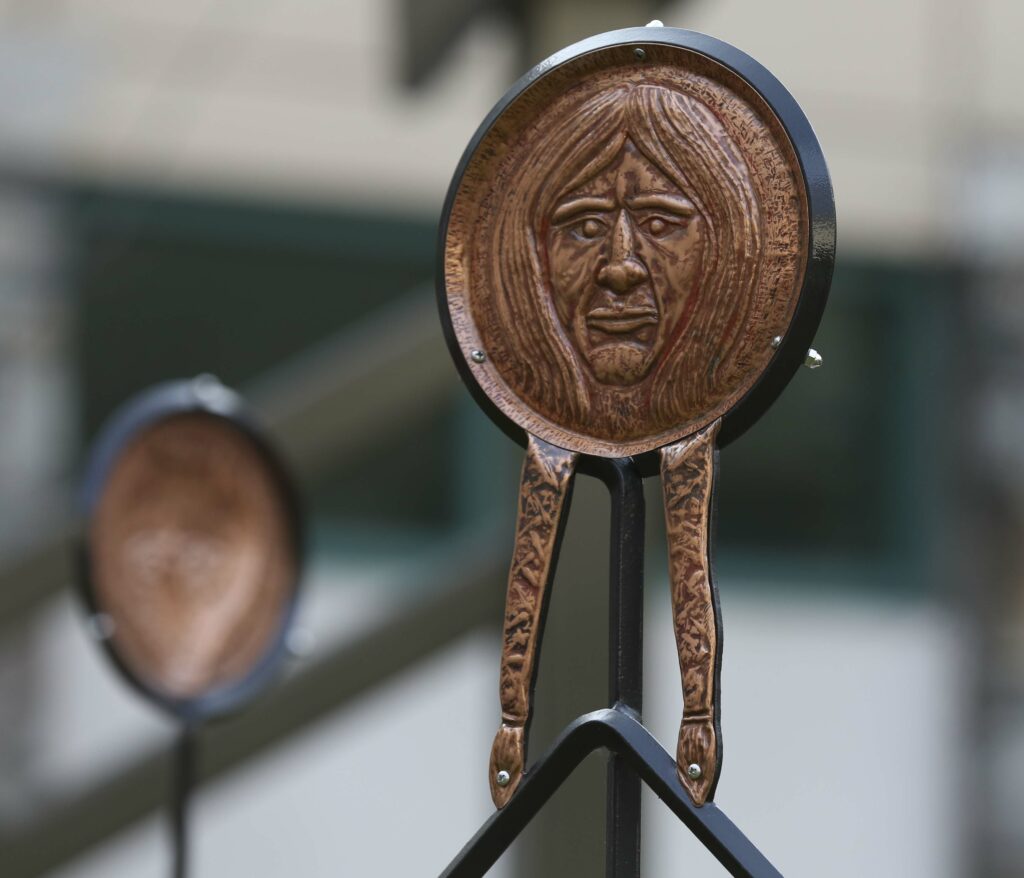
Seven pieces representing Cherokee Clan Masks are included in the copper sculpture including this one representing the Long Hair Clan.


